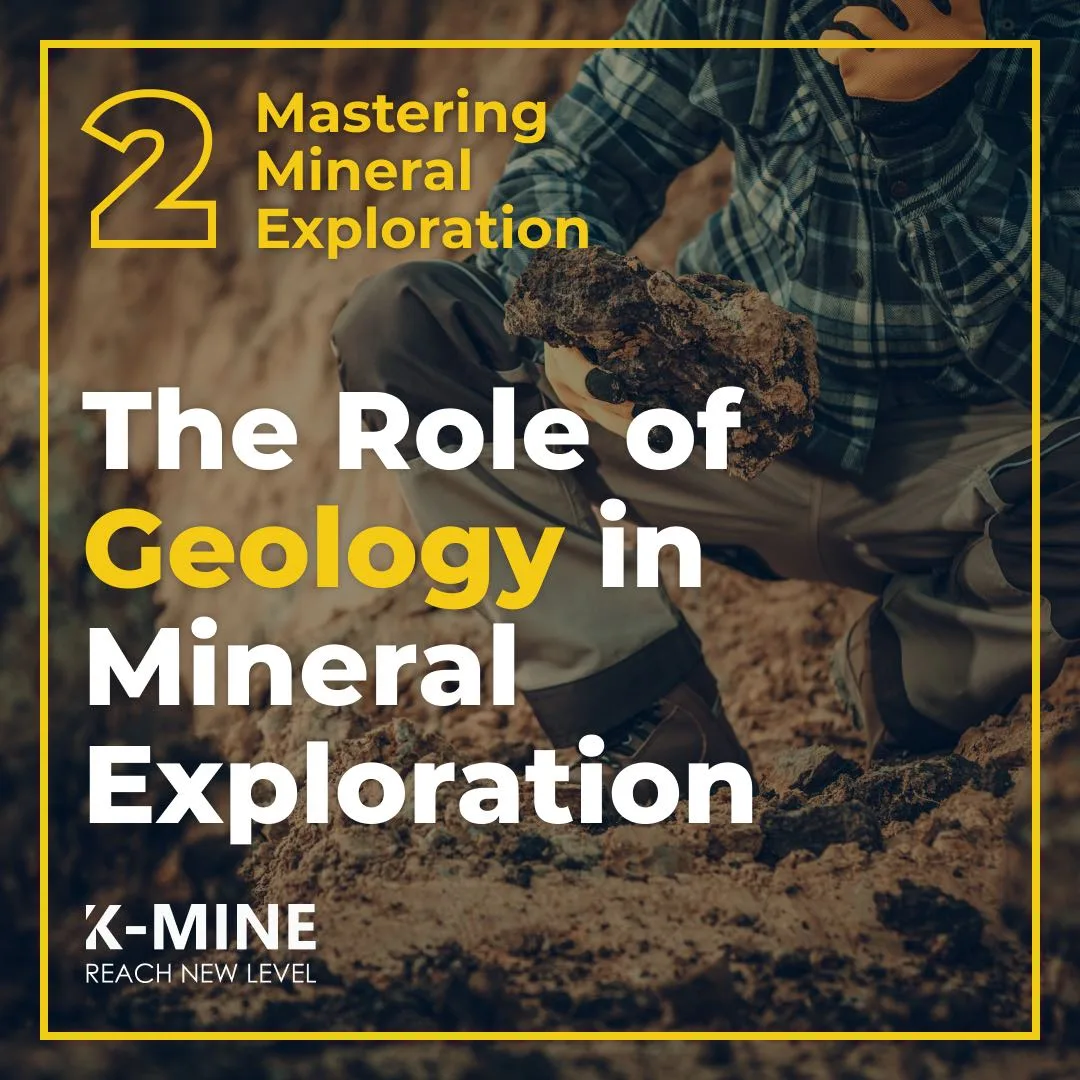
Content
Mineral exploration is a complex and sophisticated process that forms the foundation of the mining industry. Central to this process is geology, the study of the solid Earth and the processes by which it is shaped and changed. Geology provides the critical data that informs where mining companies should invest their exploration efforts. It is the roadmap that guides explorers to the hidden treasures beneath the Earth’s surface. In this article, the second in our series “Mastering Mineral Exploration: From Concept to Discovery,” we will delve into the pivotal role that geology plays in mineral exploration.
Understanding Geological Processes
To grasp the essence of mineral exploration, one must first understand the fundamental geological processes that lead to the formation of mineral deposits. This involves studying the Earth’s crust – the lithosphere – and understanding how various types of rocks and minerals form.
Our planet is a dynamic entity, with tectonic forces causing continual changes in the crust over millions of years. There are three types of rocks: igneous, formed from solidified magma or lava; sedimentary, formed from the accumulated debris of other rocks or biological material; and metamorphic, formed when existing rocks are altered through intense heat and pressure. The creation, transformation, and interaction of these rocks result in a variety of geological formations and, importantly, the concentration of minerals into economically viable deposits.
These processes are highly complex, influenced by a host of variables such as temperature, pressure, chemical environment, and even biological activity. By studying these processes and understanding how they contribute to the formation and location of mineral deposits, geologists can identify promising sites for more detailed exploration.
The Importance of Geology in Mineral Exploration
When it comes to mineral exploration, a strong understanding of geology is not just beneficial—it’s absolutely crucial. By studying the Earth’s geology, exploration teams can identify where mineral deposits are likely to be found and where to focus their efforts.
One of the key tasks in mineral exploration is selecting potential sites for further investigation. Certain types of geological formations and features are associated with specific minerals.
Moreover, geology influences the strategy and techniques used in exploration. Different geological environments require different exploration methods, and understanding the geology of an area can help determine the most effective and efficient approach. For instance, in an area with a lot of sedimentary rock, certain types of surveying or sampling might be more effective than in an area with a lot of igneous rock.
Finally, a comprehensive understanding of geology can help reduce risk and increase the chances of success in mineral exploration. By enabling more informed decision-making and more targeted exploration efforts. In the following sections, we’ll look at some specific types of geological data that geologists use in mineral exploration and how they interpret this data.
Types of Geological Data in Mineral Exploration
There’s a wide variety of geological data that can play a role in mineral exploration. This data can provide valuable insights into the geological history of an area and its potential for mineralization. Let’s take a look at some of the key types of geological data that are often collected during mineral exploration:
- Rock Types: The types of rock present in an area can tell a geologist a lot about the geological processes that have occurred there. For example, the presence of certain igneous or metamorphic rocks might indicate a history of volcanic activity or tectonic movement, which could be associated with mineral deposits.
- Structural Data: This refers to the physical attributes of rocks and geological formations, such as their shape, size, orientation, and relationships with other structures. Structural data can help geologists understand the deformation history of an area and identify geological features that might host mineral deposits.
- Geochemical Data: The chemical composition of rocks, soil, water, and even vegetation can provide clues about the presence of mineral deposits. Geochemical sampling can detect anomalies – places where the concentration of certain elements is higher than usual – that might indicate mineralization.
- Geophysical Data: This can include a wide range of data collected using geophysical methods, like seismic, magnetic, or gravity surveys. These methods can help identify subsurface structures and variations in rock properties that might be associated with mineral deposits.
- Stratigraphic Data: This involves studying layers of rock to understand the sequence of geological events in an area. This can help identify potential reservoirs or sources of minerals.
These are just a few examples. The specific types of geological data collected can vary greatly depending on the characteristics of the exploration area and the type of minerals being sought.
Interpreting Geological Data
Interpreting geological data is a vital part of mineral exploration. This process involves taking the raw data that’s been collected and using it to develop a comprehensive understanding of the subsurface geology and the potential for mineralization. Let’s delve deeper into how this works:
- Developing a Geological Model: Geologists use the collected data to build a model of the subsurface geology. This involves identifying and mapping the different geological units present, interpreting their origins and history, and understanding their relationships with each other. This can help identify structures like faults and folds, or changes in rock types, that might be associated with mineral deposits.
- Predicting Mineral Deposits: Once they have a comprehensive understanding of the geological context, geologists can begin to make predictions about where mineral deposits might be located. For example, they might look for geological settings that are known to host certain types of deposits, or use geochemical data to identify anomalies that could indicate mineralization.
- Assessing Deposit Potential: Geologists also use the collected data to assess the potential value of a deposit. This involves estimating the size and grade of the deposit, and assessing factors like the depth of the deposit and the complexity of the geology, which can impact the feasibility of mining.
Throughout this process, geologists must continually update their interpretations as new data becomes available. This iterative approach helps to refine the geological model over time and progressively narrow down the search for valuable mineral deposits.
Geological Mapping and Remote Sensing
When it comes to mineral exploration, the tools that a geologist employs play a crucial role in understanding the geology of an area. Two of these important tools are geological mapping and remote sensing techniques.
Geological Mapping: This is one of the fundamental techniques used in mineral exploration. In essence, geological mapping involves recording the types of rocks and their relationships, structural features (like faults and folds), and any surface indications of mineralization in an area. It is carried out at different scales. Large-scale mapping provides detailed information about the geology of a specific area, while regional-scale mapping gives a broad overview of the geological trends over a larger area. Geological maps serve as a visual tool, providing a spatial context that guides exploration.
Remote Sensing: In addition to traditional field mapping, geologists now also have access to an array of remote sensing technologies that can provide valuable information about the geology of an area. These include aerial photography, satellite imagery, and various types of geophysical data. Remote sensing techniques can cover large areas quickly, providing a broad overview of regional geology. They are especially useful in inaccessible or challenging terrains where field mapping may be difficult.
By combining field observations with remote sensing data, geologists can develop a comprehensive understanding of the surface and subsurface geology, which guides the mineral exploration process. But the work doesn’t stop there.
The Role of Technology in Geological Exploration
In the evolving world of mineral exploration, technology has become an invaluable partner, not just in data collection, but also in the interpretation of geological data. Let’s delve a bit deeper into the technologies that are revolutionizing geological exploration.
Advanced Analytical Tools: The interpretation of geological data has been greatly enhanced by advanced software applications. These tools enable geologists to create three-dimensional models of the subsurface geology based on the collected data, visualize potential mineral deposits, and predict their extent and value with a higher degree of confidence.
Geophysical Technologies: Advanced geophysical technologies such as seismic surveys, magnetic surveys, and gravity surveys provide detailed information about the subsurface geology without the need for invasive methods like drilling. These techniques are based on the differences in the physical properties of rocks, allowing geologists to identify potential mineral-rich zones.
Remote Sensing Technologies: As mentioned earlier, remote sensing technologies have greatly expanded the ability of geologists to survey large and inaccessible areas. Technologies like hyperspectral imaging can provide a wealth of geochemical information, aiding in the detection of mineral deposits.
Automation and Artificial Intelligence: Automation in data collection and artificial intelligence (AI) in data analysis are also becoming increasingly important in geological exploration. Automated drilling rigs can collect large amounts of data quickly, while AI algorithms can process and analyze this data, identifying patterns and anomalies that might indicate the presence of a mineral deposit.
Incorporating these technological advancements in the process of geological exploration has greatly enhanced the efficiency, speed, and accuracy of mineral discovery.
Challenges in Geological Exploration
Geological exploration, despite its numerous advancements and refined techniques, is not without its challenges. Each exploration site brings a unique set of conditions, obstacles, and problems that need to be overcome to achieve successful exploration outcomes. Let’s look at a few common challenges encountered during this process.
Variable Terrain: Each exploration site is unique in its terrain, which can vary from flat and accessible to mountainous and remote. This variability in terrain can make data collection and interpretation a challenging task. For instance, accessing remote or rugged terrain can be logistically difficult and expensive, while interpreting data from complex geological settings requires a high level of expertise.
Data Interpretation Difficulties: Even with advanced technology and sophisticated software, the interpretation of geological data is not straightforward. It requires experienced geologists who can analyze the data, make sense of it, and create accurate models to guide the exploration process. Misinterpretations can lead to costly mistakes and missed opportunities.
Environmental Considerations: Environmental sustainability is a significant consideration in all stages of mineral exploration, including geological exploration. Ensuring that exploration activities do not negatively impact the environment is a complex challenge. This involves minimizing disturbance to the landscape, avoiding damage to biodiversity, and preventing pollution of air and water resources.
These challenges, among others, highlight the need for continuous learning, adaptation, and innovation in the field of geological exploration. By understanding and addressing these challenges, we can enhance the efficiency and success of our mineral exploration efforts.
Conclusion
We’ve established how an understanding of geological processes plays a vital role in locating and assessing potential mineral deposits. From guiding the selection of exploration sites to shaping exploration strategies, geology is at the very heart of the quest for valuable minerals.
We’ve also explored the various types of geological data used in exploration, ranging from rock types and structures to geochemical data. Moreover, we’ve discussed how this data is interpreted to build subsurface models and predict potential mineral deposit locations. This process, though challenging, is fundamental to successful mineral exploration.
Lastly, we’ve highlighted the role of modern technology in improving the accuracy and efficiency of geological data collection and interpretation. While technology has its role, it’s also important to acknowledge the continued relevance of traditional techniques like geological mapping and remote sensing.
As we conclude, we understand that geological exploration isn’t devoid of challenges. From variable terrains to the difficulties in data interpretation and environmental considerations, these challenges need continuous learning, adaptation, and innovative thinking.



 Back
Back